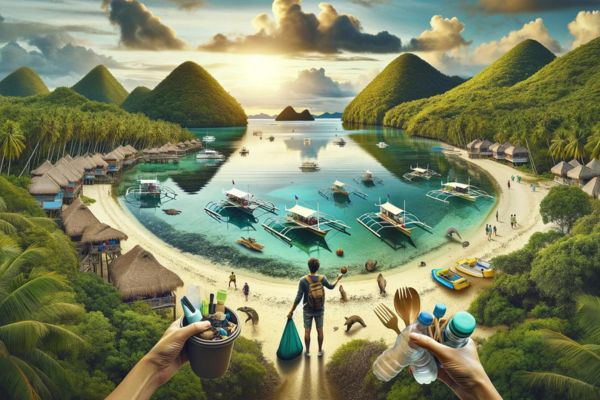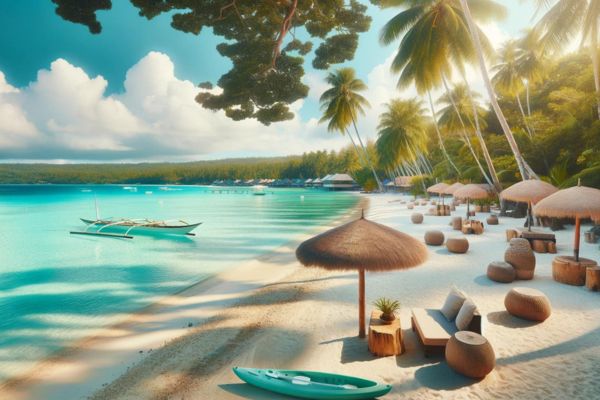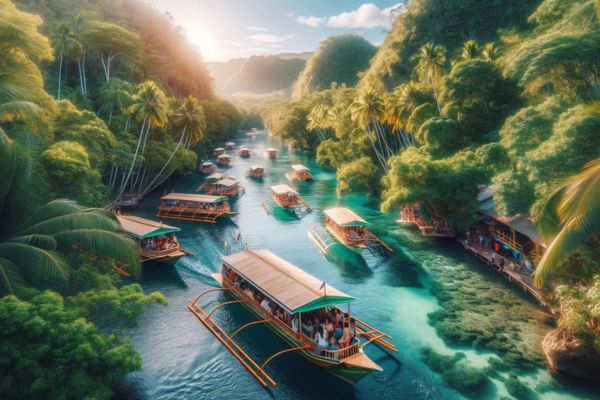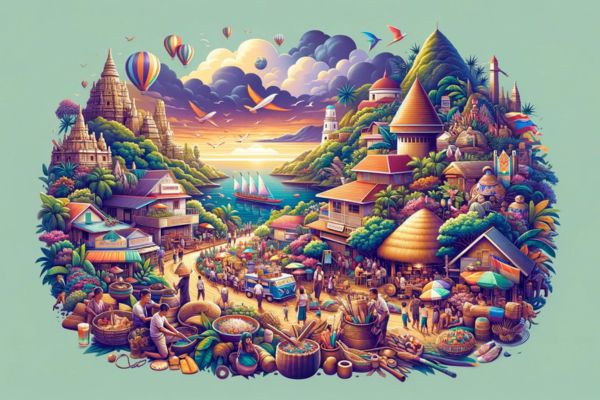Responsible Tourism in Bohol: A Guide to Sustainable Travel
Bohol, is a pioneer in ecotourism. This island province combines natural beauty with a commitment to sustainability, showcasing how tourism can flourish while respecting the environment. As one of the world’s prime examples of eco-friendly travel, the nature of Bohol offers a pristine and unparalleled experience that sets a benchmark for responsible tourism in Southeast Asia and beyond.
| Key Takeaway | Description |
|---|---|
| Community Involvement | Local communities are integral to Bohol’s eco-tourism success, benefiting from and contributing to conservation efforts and sustainable tourism development. |
| Sustainable Infrastructure | The Bohol-Panglao International Airport, known as the first eco-airport in the Philippines, exemplifies Bohol’s innovative approach to sustainable infrastructure. |
| Natural and Cultural Preservation | Efforts to protect Bohol’s ecosystems and cultural heritage ensure that its natural wonders and cultural landmarks remain vibrant and accessible for future generations. |
| Eco-Tourism Attractions | Bohol’s eco-tourism attractions, like the Chocolate Hills and Tarsier Sanctuary, offer responsible ways for tourists to experience the island’s natural beauty while supporting conservation. |
| Responsible Tourism Practices | Bohol promotes responsible visitor guidelines, including reducing waste, supporting local businesses, and engaging in eco-friendly activities. |
| Future Challenges and Directions | Bohol faces challenges such as balancing tourism growth with conservation and addressing climate change impacts, with plans for innovative solutions and community-based initiatives. |
Why Bohol Stands Out
- Unique Biodiversity: Home to the tarsier, one of the smallest primates, Bohol’s diverse ecosystems are a haven for nature lovers. The island’s efforts to protect its unique wildlife and habitats make it a standout destination for eco-conscious travelers. Bohol’s ecotourism initiatives play a crucial role in safeguarding species that are endangered and preserving the lush greenery that defines the island of Bohol.
- Sustainable Practices: From local conservation initiatives to eco-friendly accommodations, Bohol exemplifies how sustainable practices can enhance tourism experiences. The Bohol Environmental Management Office, in collaboration with the provincial government, spearheads these initiatives, underscoring the province’s commitment to sustainability. This approach not only preserves Bohol’s environment but also positions the island as a leading tourist destination for those seeking an eco-conscious vacation.
The Importance of Preserving Nature and Culture
- Ecosystem Protection: Bohol’s eco-tourism initiatives focus on safeguarding its rich ecosystems, from the coral reefs to mangrove forests. These efforts ensure that the island’s natural wonders, such as the pristine white sand beaches and the unique limestone formations, remain vibrant and accessible for future generations. The Bohol Environment Code is a testament to the province’s dedication to environmental preservation.
- Cultural Heritage: The preservation of Bohol’s cultural landmarks, such as centuries-old churches and traditional festivities, is integral to its tourism appeal. Celebrating and maintaining these cultural aspects enrich the visitor experience and fosters a deeper appreciation for Bohol’s heritage. This integration of culture and nature makes Bohol not just a Philippine island of beauty but a tourism destination with a soul.
Responsible Practices for Tourists
Bohol encourages visitors to adopt sustainable practices, reinforcing the island’s status as a pioneering eco-tourism destination in Southeast Asia.

How You Can Help: Responsible Visitor Guidelines
- Reduce, Reuse, Recycle: Tourists are urged to follow these principles to minimize their environmental impact. This initiative is part of Bohol’s broader strategy to manage waste effectively, particularly in tourist-heavy areas like Panglao shores, ensuring that Bohol’s environment remains unspoiled.
- Support Local Businesses: By choosing local accommodations and dining options, tourists contribute to the local economy and learn about the unique culture of Bohol. This practice is encouraged to promote sustainable economic growth and support the province’s efforts to provide eco-friendly tourist experiences. If you want to learn more about supporting local businesses in Bohol, click here.
Eco-Friendly Stays and Activities
- Green Accommodations: Resorts and hotels in Bohol, such as the South Palms Resort Panglao, are lauded for their eco-conscious amenities. These accommodations are part of Bohol’s commitment to sustainable tourism, offering guests a comfortable stay that aligns with environmental conservation efforts.
- Sustainable Tours: Bohol offers a variety of eco-tourism activities, from mangrove adventure tours to diving spots renowned for their biodiversity. These tours are designed to immerse tourists in the natural beauty of Bohol while fostering a deeper understanding of the importance of conservation, further solidifying the island’s reputation as a premier eco-tourism destination in the Philippines and Southeast Asia.
Bohol’s Journey towards Sustainability
The transition to a sustainable tourism model in Bohol showcases the island’s dedication to environmental and cultural preservation. Through the concerted efforts of the tourism office and local communities, Bohol has become a model for national ecotourism, setting an example for other destinations like Boracay and Palawan.

From Past Challenges to Sustainable Solutions
- Environmental Threats: Initially facing challenges like deforestation and overfishing, Bohol has made significant strides towards conservation. By adopting policies that promote sustainable tourism and environmental protection, the island has turned past adversities into opportunities for growth. The Bohol-Panglao International Airport, celebrated as the first eco-airport in the Philippines, exemplifies this shift towards innovative sustainable solutions.
- Community Engagement: The active participation of local communities in eco-tourism projects has been crucial. Initiatives that involve locals in conservation and tourism efforts have led to more sustainable and inclusive development. Empowerment through training and education ensures that the community remains at the forefront of Bohol’s eco-tourism efforts, equipped with the knowledge and skills to sustain them.
Innovative Infrastructure: The Eco-Airport
- Bohol-Panglao International Airport: This facility sets a benchmark for green infrastructure in the Philippines, featuring solar power and natural ventilation. It embodies Bohol’s commitment to sustainable development, serving as a gateway for eco-conscious travelers. As the main island’s green gateway, this airport is a significant step forward in Bohol’s journey towards becoming one of the world’s top biodiversity areas.
- Green Technologies: The use of renewable energy and eco-friendly designs minimizes the airport’s carbon footprint. These innovations are part of Bohol’s broader strategy to promote responsible tourism that respects the environment. The eco-airport is a clear indicator of Bohol’s future development in eco-tourism, highlighting the province’s efforts to balance tourist influx with environmental preservation.
Key Eco-Tourism Attractions in Bohol
Bohol is celebrated for its commitment to sustainability and its eco-tourism attractions that draw visitors from around the globe, contributing to the island’s reputation as a premier tourism destination in Southeast Asia. Here’s a closer look at some of these natural wonders and conservation efforts:

Protecting the Tarsier: Corella’s Sanctuary Efforts
- Tarsier Conservation Area: Dedicated to protecting the Philippine tarsier, this sanctuary in Corella showcases Bohol’s dedication to wildlife conservation. It’s a pivotal part of Bohol’s ecotourism, attracting tourists who are eager to see these endangered primates up close while learning about the importance of preserving their natural habitat in the lush forests of Bohol.
- Educational Tours: Offering guided tours that educate visitors on the tarsier’s habits and conservation efforts, the sanctuary not only protects tarsiers but also raises awareness about biodiversity. These initiatives are crucial for sustaining the natural beauty and ecological balance of the Bohol province, making it a key player in ASEAN tourism and national ecotourism efforts.
Chocolate Hills: Eco-Tourism’s Crown Jewel
- Natural Wonder: The Chocolate Hills are Bohol’s most iconic landmark, symbolizing the unique geological history of the island. These hills are a prime example of how nature and ecotourism can coexist, drawing tourists from around the world to witness their beauty while emphasizing the need for conservation in the face of mass tourism.
- Sustainable Viewing: The provision of eco-friendly viewing platforms ensures visitors can enjoy the Chocolate Hills without impacting their pristine condition. This approach reflects Bohol’s commitment to sustainable tourism practices, highlighting the island as a model for responsible travel in the Philippines and a top biodiversity area.
Beach and Mangrove: Leisure Meets Conservation
- Panglao Island Beaches: Famous for their white-sand beaches and crystal-clear waters, the beaches of Panglao Island are among tourists’ favorite destinations. Efforts to protect these beaches from the adverse effects of tourism underscore the balance Bohol seeks to maintain between offering leisure experiences and conserving its pristine natural environments.
- Mangrove Reforestation: The mangrove reforestation projects around Bohol serve as a vital part of the island’s eco-tourism, supporting marine life and providing natural protection against erosion. These efforts are a testament to the community’s involvement in preserving the nature of Bohol, ensuring it remains a green gateway for future generations.
Under the Sea: Responsible Snorkeling
- Coral Preservation: Bohol’s coral reefs, rich in marine life, offer unparalleled snorkeling experiences. The emphasis on coral preservation during these activities showcases Bohol’s dedication to protecting its marine biodiversity, making it a sought-after destination for eco-conscious divers and snorkelers.
- Marine Sanctuaries: Managed snorkeling experiences in areas like Balicasag Island highlight Bohol’s innovative approach to marine conservation. These sanctuaries are not just tourist attractions but are critical for the research and rehabilitation of marine species, further establishing Bohol’s position as a leader in ecotourism within the Central Visayas region and beyond.
Community Involvement in Eco-Tourism
Bohol’s eco-tourism success is deeply rooted in community involvement, showcasing a collaborative approach to sustainable development. This involvement not only supports conservation efforts but also empowers residents by creating sustainable livelihoods, highlighting the province’s commitment to inclusive growth.

Empowering Local Communities
- Community-Based Tourism Projects: Initiatives like the Loboc River Cruise and Anda’s Community Tours demonstrate how tourism can benefit local populations directly. These projects provide income opportunities for residents and encourage the preservation of Bohol’s culture and traditions, reinforcing the island’s status as a vibrant tourism destination within the Philippines.
- Training and Education: The provincial government and the Bohol Environmental Management Office offer programs focusing on sustainable tourism practices. This education empowers locals to lead conservation efforts, ensuring that Bohol’s eco-tourism initiatives are sustainable and community-driven, making it a model for future development in ASEAN tourism.
Community-Based Tourism
- Tarsier Sanctuary in Corella: Managed by locals, this sanctuary not only protects the tarsiers but also provides employment and educational opportunities for the community. It’s a prime example of successful eco-tourism that benefits both the environment and the local economy, showcasing Bohol’s holistic approach to sustainable development.
- Balicasag Island Dive Resorts: Operated in collaboration with conservation organizations, these resorts offer eco-friendly diving experiences. They serve as a model for how marine conservation can align with economic benefits for local communities, contributing to Bohol’s reputation as a leading destination for responsible snorkeling and diving in Southeast Asia.
Challenges and Future Directions
Despite its achievements, Bohol faces ongoing challenges in eco-tourism, including balancing tourism growth with environmental preservation and addressing the impacts of climate change. These challenges necessitate innovative solutions and continued commitment to sustainable practices.
Overcoming Obstacles for Sustainable Growth
- Balancing Tourism and Conservation: As Bohol becomes increasingly popular among tourists, managing the impact of visitor influx on natural resources is crucial. Strategies to balance development with conservation are essential, ensuring that Bohol remains a pristine and sustainable eco-tourism destination.
- Climate Change Impacts: The effects of climate change pose significant threats to Bohol’s natural ecosystems. Developing adaptation and resilience strategies is vital for protecting the island’s biodiversity and ensuring the sustainability of its tourism industry.
What’s Next for Bohol’s Eco-Tourism
- Innovative Sustainable Solutions: Exploring renewable energy sources and implementing sustainable waste management systems are among Bohol’s priorities. These initiatives aim to enhance the island’s eco-tourism infrastructure, setting a standard for future development in the province and across Southeast Asia.
- Expansion of Community-Based Initiatives: By extending successful community-based tourism projects to more areas, Bohol can further distribute tourism benefits and encourage widespread participation in conservation efforts. This expansion will reinforce the island’s commitment to sustainable and inclusive eco-tourism development.
Final Thoughts
Bohol’s journey in eco-tourism is a testament to the possibility of harmonizing tourism with environmental and cultural preservation. Its commitment to sustainable practices, community involvement, and conservation sets a benchmark for eco-tourism in the ASEAN region and beyond. As Bohol continues to navigate the challenges of sustainable development, its efforts offer hope and inspiration for the future of global tourism.
By choosing to visit Bohol, tourists contribute to a movement towards responsible and sustainable travel. They experience not only the splendor of the Philippines but also the impactful difference that mindful travel can make in preserving the beauty of our planet for future generations. Bohol’s initiatives, from the protection of the tarsier to the operation of the first eco-airport, highlight the island’s dedication to a sustainable future, making it a beacon of eco-tourism in the heart of Southeast Asia.
As I website owner I think the articles here is rattling superb , thanks for your efforts.
Excellent read, I just passed this onto a friend who was doing a little research on that. And he actually bought me lunch as I found it for him smile Therefore let me rephrase that: Thank you for lunch!